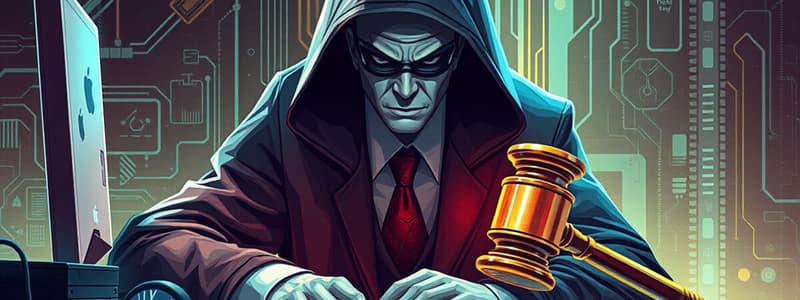Podcast
Questions and Answers
What complicates the jurisdiction in computer crime cases?
What complicates the jurisdiction in computer crime cases?
- Virtual crimes may not have physical locations (correct)
- Only courts have jurisdiction
- Crimes are based only on location of the criminal
- All crimes happen in one country
Anonymity can embolden individuals to commit computer crimes.
Anonymity can embolden individuals to commit computer crimes.
True (A)
Which of the following individuals is considered perhaps the most famous early hacker?
Which of the following individuals is considered perhaps the most famous early hacker?
- Kevin Mitnick (correct)
- cOmrade
- Terminus
- Shadowhawk
Name one historical computer crime mentioned.
Name one historical computer crime mentioned.
Phreaking involves the honest use of telecommunications services.
Phreaking involves the honest use of telecommunications services.
The encoding of information to make it unreadable is known as __________.
The encoding of information to make it unreadable is known as __________.
Match the following computer crimes with their descriptions:
Match the following computer crimes with their descriptions:
What device was commonly used in phreaking to deceive switching systems and make free calls?
What device was commonly used in phreaking to deceive switching systems and make free calls?
In the early days, those with criminal intentions were called __________.
In the early days, those with criminal intentions were called __________.
Which organization is associated with the early form of computer crime involving hacking?
Which organization is associated with the early form of computer crime involving hacking?
Match the terms with their descriptions:
Match the terms with their descriptions:
Encryption makes it easier to prosecute computer crimes.
Encryption makes it easier to prosecute computer crimes.
What are two factors that define the challenges in recognizing computer crimes?
What are two factors that define the challenges in recognizing computer crimes?
What is one contemporary motivation for hacking?
What is one contemporary motivation for hacking?
The ideology behind hacking has remained unchanged since its inception.
The ideology behind hacking has remained unchanged since its inception.
The Morris Worm caused millions in damages in the year __________.
The Morris Worm caused millions in damages in the year __________.
What is one consequence of a delay in detecting computer crimes?
What is one consequence of a delay in detecting computer crimes?
Who was the first teenager to be incarcerated for hacking?
Who was the first teenager to be incarcerated for hacking?
__________ refers to the manipulation of telecommunications carriers for illegal purposes.
__________ refers to the manipulation of telecommunications carriers for illegal purposes.
Which of the following is a common characteristic of script kiddies?
Which of the following is a common characteristic of script kiddies?
Flashcards are hidden until you start studying
Study Notes
Continuum of Computer Crimes
- Varying degrees of technical sophistication among computer criminals suggest a continuum of offense seriousness.
- Investigating agencies must possess varying levels of technical expertise, impacting crime resolution.
Challenges in Computer Crime Investigation
- Jurisdiction issues arise as crimes can occur across multiple locations, complicating legal frameworks based on geographic locality.
- Lack of international cooperation hampers investigations, intensified by judicial inconsistencies and cultural skepticism.
Technical Factors in Prosecution
- Encryption and steganography complicate prosecution by obscuring information.
- Delay in crime detection increases the chance of offenders evading justice.
- Perception of anonymity encourages some individuals to commit crimes with less fear of repercussions.
Definition and Recognition of Computer Crimes
- Identifying computer crimes depends on the targets (individuals, organizations, or nations) and the nature of the illegal activities.
- Means of perpetration vary; hacking demands technological skills while simpler frauds, like phishing, may require less.
Historical Context of Computer Crime
- Early computer crimes included physical theft and sabotage, impacting technology like Jacquard’s automated textile machine.
- MILNET incident in 1986 saw a KGB hacker infiltrate a military network; discovered by a programmer inadvertently.
- The Morris Worm, released in 1988, spread rapidly, inflicting substantial damage and leading to legal consequences for its creator.
AT&T Crash Incident
- A software failure led to the AT&T crash, highlighting system vulnerabilities, involving alleged hackers, the Legion of Doom.
- Investigation faced criticism due to overreactions targeting innocent parties, embarrassing federal law enforcement.
Early Hackers and Pioneers
- Notable early hackers include Kevin Mitnick, cOmrade, Terminus, Shadowhawk, and Kyrie, who contributed to the hacking narrative.
Phreaking Practices
- Phreaking involves manipulating telecommunications for knowledge and unauthorized service access.
- Techniques include social engineering and devices like blue boxes to exploit telecom systems.
Evolution of Hacking
- Hacking in the 1960s was often benign, focusing on discovering shortcuts and engaging in clever pranks.
- As criminal intentions emerged, "crackers" differentiated between benign hackers and those with malicious intent.
Motivations Behind Hacking
- Contemporary motivations for hacking include financial gain, revenge, fame, curiosity, intellectual challenges, and political aims.
- Sexual gratification and informational voyeurism have also become underlying motives for certain hackers.
Script Kiddies
- Inexperienced hackers known as script kiddies use others' scripts to exploit systems without understanding the technology.
- Terms like skidiots or Victor Skill Deficiency (VSD) refer to this group, highlighting a lack of technical expertise.
Studying That Suits You
Use AI to generate personalized quizzes and flashcards to suit your learning preferences.



